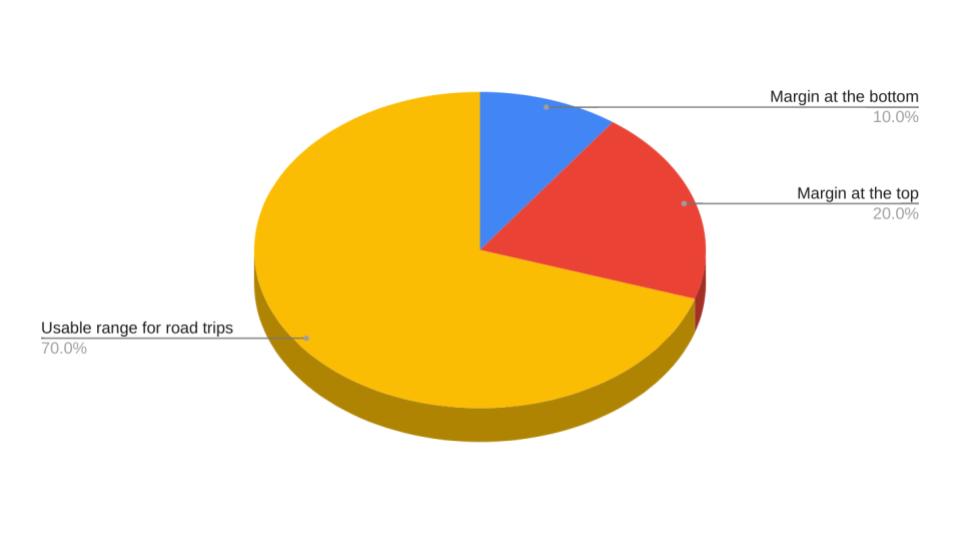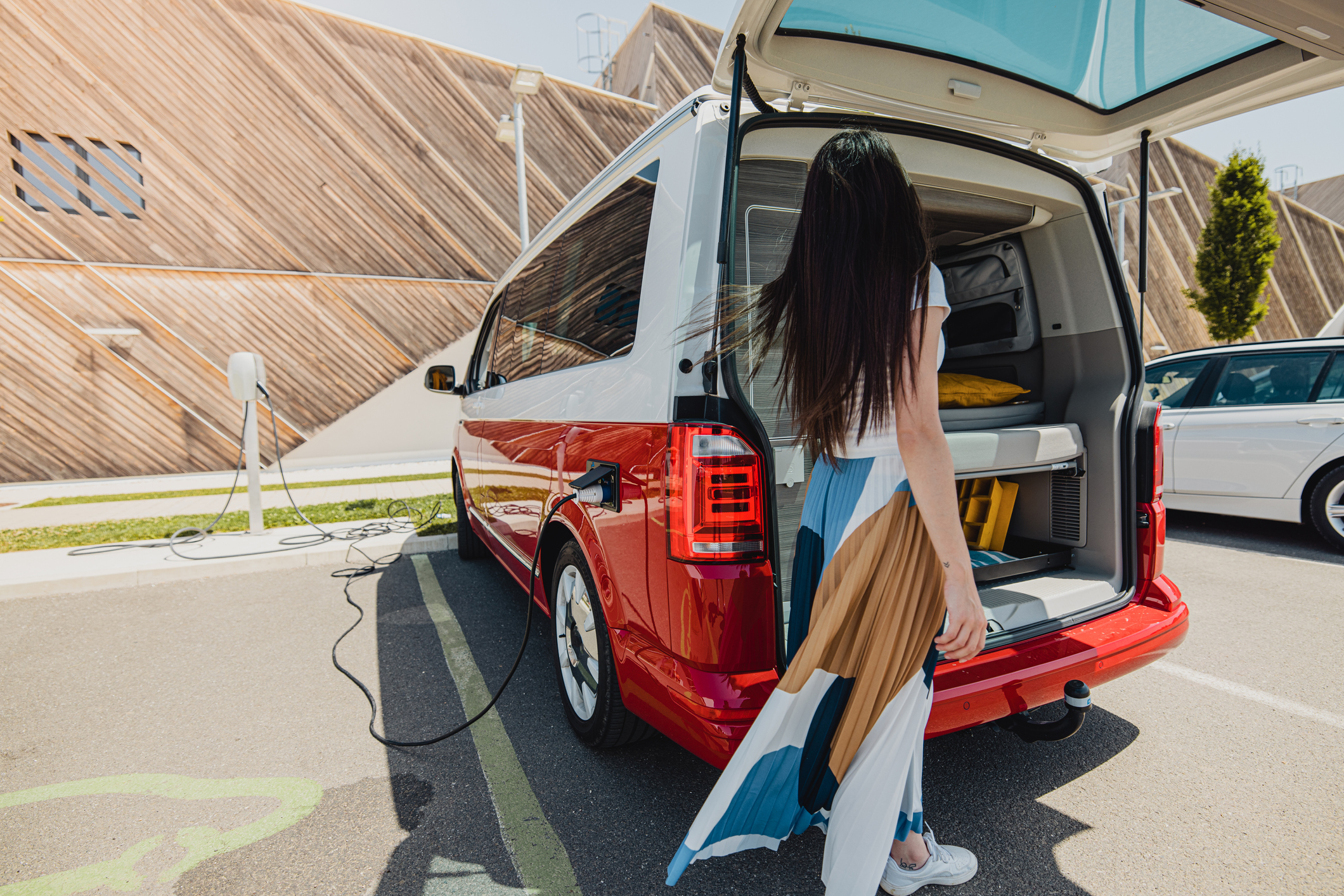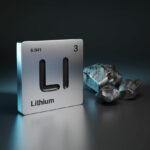TL;DR
Battery size is one of the most important questions to consider when buying an EV.
If you are like most people, you didn’t time the fill-ups in your gas-powered car so that you rolled into the gas station when you had 0 miles of range left. Similarly, you won’t use your EV’s last mile of range as you pull into a charging station. At least not on a regular basis.
My rule of thumb is to assume you can use about 70% of the rated miles when planning a road trip. The remaining 30% is locked away for margin, as explained by my 10/20/70 rule.
The Nitty Gritty Details of Sizing Up Your Battery
Assume you just bought a new EV with a range of 300 miles, and you have a 600-mile journey ahead of you. It might be tempting to think you’ll only need to stop and charge once: tempting, but naive.
There is the very real human trait of not wanting to roll into the charging station on your last electron, assuming there is a charging station right at mile 300. Furthermore, as we learned in a previous column, there are a lot of variables when calculating range – the guess-o-meter (GOM) is merely an estimate.
Similarly to how the typical driver approaches driving an ICE-mobile (where you start looking for a fill-up when the needle is below ¼, but somewhat above the “E”), an EV driver rarely lets their battery drop all the way to zero before plugging in. That works out to be about roughly 10% of a tank, and I’ve found this translates pretty well to driving electric. Interestingly, this is roughly independent of range. When I drove my home-built Miata with a range of 50 miles, I would start to squirm in the driver’s seat when I got down to my last 5 miles. Now I drive a car with roughly 400 miles of range, and I’m pretty laid back until I get down to my last 40 miles.
My rule of thumb is that 10% of your car’s battery range is for margin on the bottom. Now let’s look at the margin on the top of the battery.
Wait, you say. Why would I keep a margin on the top of the battery? Why not just charge it to 100 percent?! Well, when you’re charging at home (or another destination where time is not a factor), feel free to do just that. But when considering how big of a battery you want in your EV, most people tend to think of sizing in terms of what they need for road trips. Most drivers’ needs around their homes are far less than what they may want on a long-distance journey.
What is important to remember is that charging slows down as the battery gets above 80 percent state of charge (SOC). We’ll cover this in more detail in a future column, but for now, just know this fact is rooted in physics. Every battery manufacturer’s charge profile is a bit different, but all batteries will slow as their SOC gets higher, and the typical “knee of the curve” when charging starts to get painfully slow is around 80 percent.
That’s the source of the “20” in my 10/20/70 rule; to maintain a 20 percent margin for the top of the charge cycle when DC fast charging during a road trip. The reality is that when charging on the road, as your charge rate slows down, time pressures overrule getting those last couple of miles.
For planning purposes, that’s 10 percent at the bottom of the charge cycle and 20 percent at the top, leaving you 70 percent of the battery for a comfortable, stress-free road trip.
Assuming you’re in the market for a new EV, the next question to ask yourself is how long you want to stay behind the wheel before you need to stretch your legs or use the restroom. One source I found suggested taking a break every two hours during a road trip. That’s roughly my limit, so for the sake of discussion, let’s use two hours as an example.
Two hours at an assumed 70 MPH freeway speed will require about 140 miles of range. Apply the 10/20/70 rule, and you’d want to use a maximum of 70 percent of your battery to cover those 140 miles. Dividing 140 by 0.7 (70 percent) leaves us with 200 miles. Armed with this information, when you start shopping for an EV, you should only look at EVs with at least 200 miles of range, which, thankfully, consists of most EVs on the market in 2023.
I should mention that the range in very cold climates can drop by up to 50 percent. We’ll cover the reasons why in a future column, but it’s important to factor in that drop in range if you live in (or plan to drive to) cold climates.

The 10/20/70 rule is personal, but everyone should consider their risk profile, their EV, and how they intend to use it. Maybe there are many charging options in your area, and you like living on the edge. Consider making that 10 percent on the bottom 5 percent. Your car’s charging profile doesn’t really slow down until 90? How lucky for you! Consider making that 20 percent on the top 10 percent. Just plan on spending a few brain cells on the topic if you plan to use your EV for road trips.
Feel free to adjust my 10/20/70 rule for your personal risk tolerance; by all means, you do you. The big picture here is you’re just not going to go to zero miles estimated range remaining while driving to grandma’s through central Nevada, nor are you likely to wait for those last few percentage points of SOC to trickle in as you near the top of your car’s charge cycle, so, plan accordingly.
The 10/20/70 rule is but one (of three) considerations when it comes to determining what battery size work best for you. We’ll cover the other two (DCFC placement and cold temperatures) in a later column. Next week’s topic is Batteries Don’t Hold Miles.








0 Comments